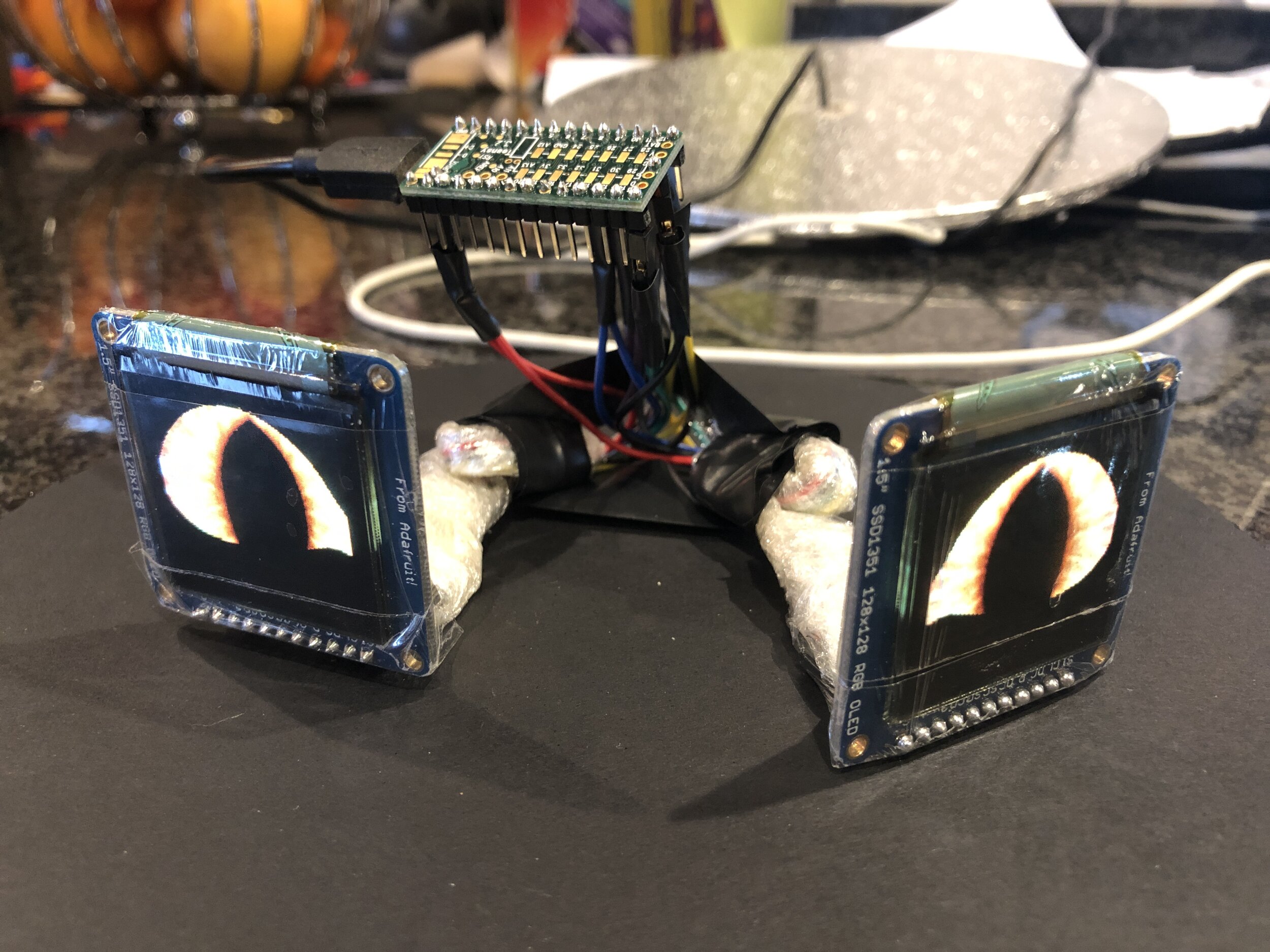Evil Cakes for Kids Part III - The Cake with a Thousand Eyes
Oscar is one lucky boy. Being an October baby makes him a Halloween baby and guess what? Here at Castle Von Baines we LOVE Halloween! It's no surprising then that all of his previous birthday cakes have had a spooky theme with last year's Harry Potter Cauldron topping the chart for most liked cake EVER. So what creepy delight would grace the party table this year? The cauldron was a tough act to follow but armed with my trusty piping bag, cake tins and soldering iron I set to work in true Shellian fashion to create a living but totally edible monster cake. It's alive!
Fortunately, in order to breath life into my monster I didn't need to rob graves or harness the power of lightning, I just needed some eyes. Not real ones of course, these eyes were created using a Teensy 3.2 microcontroller and two rather small computer monitors (1.5” OLED displays). These would be embedding in the cake to give the mass of flour, eggs and sugar some personality. A tutorial on how to build and program the eyes can be found here.
The eye circuitry was mounted in a dummy cake slice enclosure made from card. A section of cake was removed and the eye circuit was slotted into place and secured with a dollop of buttercream.
The recipe I use for my cakes is perfect for 'construction', you can stack two or three layers without the need of internal dowels for support and they don't collapse under the weight. They are light and moist but slightly denser in texture that you’d expect from a standard Victoria Sponge. I personally prefer 'heavier' moist cakes like apple cake and carrot cake
For this I used -
250g Self Raising Flour
250g Caster Sugar
250g Unsalted Butter
1 Teaspoon of Salt
4 Large Eggs (separated)
100ml Natural Yogurt
Vanilla Essence
60g Cocoa Powder (use more if you like you cakes more chocolatey)
Gently melt 250g of butter and once it is fully melted add the 250g of caster sugar and stir until smooth. Remove from the heat and place to one side to cool.
Add the salt & cocoa powder to the flour and sieve.
Separate the 4 eggs and place the whites in a mixer and beat until fluffy.
Tip the 4 yolks into the butter and sugar mixture along with a teaspoon of vanilla extract and 100ml of natural yogurt and mix.
Then add the flour to the wet mixture and gently fold until the ingredients are fully incorporated.
Finally, take the whisked egg whites and fold it into the mixture until it is fully mixed. Be sure not to over mix the batter.
Line a couple of cake tins, pour in the mixture and bake for 30 minutes at 180c. If the middle still wobbles after 30 minutes return the cake to oven for a further 5 minutes and repeat if necessary.
You can add pretty much anything to this recipe so be adventurous! My kids are boring, they only like chocolate which luckily is my least favorite meaning I don’t as many off-cuts as I normally would!
The cake consisted of three layers of chocolate sponge, with the middle layer being slightly smaller, similar to a fault line cake. This recessed area would be used to form a 360 degree mouth. The eyes were powered from a USB battery pack mounted under the cake board. To thread the wires through the cake I made a 12” long cookie cut fro Plasticard to channel a core a hole through the centre of the cake.
All of the layers were given a quick crumb coat and then placed in the fridge for half an hour while I prepared the buttercream.
Oscar has a particular fondness for chocolate orange so I whipped up a large batch of orange buttercream along with some pink and black for the mouth. The teeth were simply mini marshmallows. I had intended to make sharp teeth from white chocolate but I felt that the marshmallows gave the monster a friendlier appearance. Piping from the deepest point outwards, I started with the black followed by the pink gums.
I roughly piped the orange buttercream over the rest of the cake. I didn’t want perfect lines of icing, I was after a finish that looked slightly chaotic that emulated what I can only describe as ‘horny fur’. The ears were created using strawberry meringue swirls.
It only made sense that a creature with a 360 degree mouth should also have vision to match so I added a more eyes and an extra tongue. You never know when one could come in handy! Some parents commented on the uncanny realistic texture of the tongue. This was created by stippling the fondant icing with an egg wash brush followed by a couple of coats of confectioner’s glaze to give it a permanent dribbly wet look.
As you can see, the cake was a hit and the poor monster with a thousand eyes was promptly sliced up and shared between 20 hungry kids and their parents.
Laughter from the Underworld
I thought I'd share this interesting article from The Politic which draws together the recent spate of clown sightings and the connections with fairy folklore. Do you likes balloons Johnny?
On Saturday night, a student shared a photo of two clowns on the Facebook page “Overheard at Yale.” The figures, covered in dark face paint and lit by a nearby street lamp, stared straight at the camera, or maybe at the person behind it. This sighting, the first at Yale, adds New Haven to the growing list of cities that have experienced clown sightings, a nervous phenomenon that has taken the nation by storm. In other words, the Clownpocalypse is here.
Like most horror stories, this one began in a small southern town and features an unassuming little boy. In late August, the son of Donna Arnold reported that he had spotted two clowns—one in red and one in black—outside his apartment complex in Greenville County, South Carolina, and claimed that there were luring him into the woods. Since then, hundreds of new reports have appeared in numerous states, including Pennsylvania, Maryland, Georgia, and Texas, describing clowns engaged in a variety of unnerving activities, from standing on the roadside during the darkest hours of the night, to chasing children.
The significance of this story doesn’t just come from the momentum with which clown sightings have taken hold. The curious features of these incidents, particularly the characterizations of clowns as insidious creatures, the targeting of young children, and the largely non-violent methods of terror have strong roots in the history of clowns and in Western society itself.
Though historian Beryl Hugill is able to locate the vague form of the clown in societies as early as Ancient Greece, the roots of the modern clown stem most strongly from the Italian Renaissance and the production of a theatre genre known as “commedia dell’arte.” It is there that the Harlequinn character first made its appearance. Benjamin Radford, author of “Bad Clowns,” elaborates that the mask cladded, diamond-pattern wearing character came from the sinister veins of the religious underworld. The clown was not so humorous after all. Rather, its original identity was derived from the cackles of “lost souls”—dead people who were unable to transition to the afterlife. These lost souls would turn into a “troupe of comic demons” described as flying and dancing in the air; essentially, they were fairies.
When I use the term fairy, I’m not talking about Tinkerbell. Rather, I am referring to the mythical creatures whose origin, legend argues, was a rebellious group of angels banished by God from Heaven. The is not a story of the Devil or Satan: The fairies were not sent all the way down, but kept in a limbo between heaven and hell.
In its ancient origin, the insidious character of the clown asserts itself. Psychologists have attempted to explain “coulrophobia,” the fear of clowns, by stating that the proportions of the features, combined with the gaudy use of color, triggers an unsettling visual sensation. But the fact that coulrophobia has not been clinically listed as a phobia, but remains the lingo of pop culture suggests that the majority of people aren’t actually scared of clowns. Rather, the unsettling sense generated by clowns is derived from the acknowledgement that—despite appearances—there is a capacity, a potential for harm. The limbo of the fairies, stuck between good and bad, like the laughter of the demon, is the tension that lies beneath our fear of clowns. The thick paint that masks the features of the clown forces us to question what is underneath.
In this way, the non-violent nature of clown sightings can be contextualized. While it is very likely that many of the people dressing up as clowns are simple pranksters, and therefore do not hold criminal intentions, it is still key to note that most reports show that these clowns do not present weapons, let alone use them. Radford argues that the leering clown can be more fearful than the killer clown, as once the act of violence is committed the critical tension breaks. The dynamics of uncertainty are no longer present in the equation; the killer clown is no more fearful than that of the generic murderer.
One of the first times that the term “Killer Clown” was used was in reference to John Wayne Gacy Jr. Gacy, who often used to work as “ Pogo the Clown,” sexually assaulted and murdered 33 teenage boys in Illinois in the 1970s. His main tactic was deception. Instances like the Gacy case create the sense that it is legitimate to question the nature of the clown; they validate the subconscious tension. Depictions of clowns in pop culture also add to the impression that clowns are dangerous: the Joker from Batman, Pennywise in “It” and the chilling clown in Steven Spielberg’s Poltergeist.
The recent clown sightings have been accelerated by social media. Trends are determined almost exclusively by circulation on Facebook, Twitter, and Instagram. In this way, the recent clown sightings are a trend ultimately not so distinctive from other internet fads like the dab, Arthur memes and pictures of avocado toast. The Clownpocalypse is nothing new.
But more curious is why this trend is happening right now, at this particular moment. The last time a similar event occurred was in France and England in 2013 where, similarly, stalking clowns were reported. Mary Valle of The Guardian argues that public hysteria is produced in moments of social nervousness. The societal unease results in people finding comfort in such acts, in order to materialize a hysteria they can only feel. Valle concludes by arguing that the social anxiety produced by the American election, the antics of Donald Trump and Hillary Clinton, have resulted in what she refers to as a “real-time trauma play.”
In the fertile ground of the Internet, the seeds of another movement have been planted: #ClownLivesMatter. A number of day-job clowns have taken to social media to help people realize the effects these depictions of clowns are having on their livelihoods. Marches and rallies have been organized for the near future.
Stephen King, the creator of the infamous Pennywise, tweeted in his support: “Hey guys,” he wrote “time to cool the clown hysteria—most of em are good, cheer up the kiddies, make people laugh.” We can only hope he’s right. After all, his twitter archive also includes: “I have a button that says CAN’T SLEEP, CLOWNS WILL EAT ME. Probably not true. But what if it was? What if they’re just waiting?”
What if they’re just waiting.










